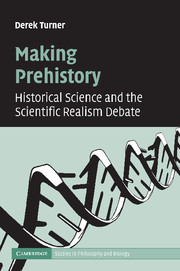Book contents
- Frontmatter
- Contents
- List of figures
- Acknowledgments
- Introduction
- 1 Asymmetries
- 2 The colors of the dinosaurs
- 3 Manipulation matters
- 4 Paleontology's chimeras
- 5 Novel predictions in historical science
- 6 Making prehistory: could the past be socially constructed?
- 7 The natural historical attitude
- 8 Snowball Earth in the balance
- Conclusion
- References
- Index
8 - Snowball Earth in the balance
Published online by Cambridge University Press: 22 September 2009
- Frontmatter
- Contents
- List of figures
- Acknowledgments
- Introduction
- 1 Asymmetries
- 2 The colors of the dinosaurs
- 3 Manipulation matters
- 4 Paleontology's chimeras
- 5 Novel predictions in historical science
- 6 Making prehistory: could the past be socially constructed?
- 7 The natural historical attitude
- 8 Snowball Earth in the balance
- Conclusion
- References
- Index
Summary
Sciences such as geology and paleobiology are collocative, in the sense that researchers in these fields typically try to gather as much evidence of as many different kinds as possible, and they try to devise coherent explanations that make sense of all the disparate evidential traces. Notions like consilience, explanatory coherence, and explanatory unification figure prominently in collocative science. But these notions also raise difficult philosophical questions: What is consilience, exactly? By what right may scientists take consilience as a guide to the truth about the past? What should someone who adopts the natural historical attitude say about the role of consilience in historical science? And what consequences might the asymmetry of manipulability and the role asymmetry of background theories have for the interpretation of appeals to consilience in historical science? No discussion of historical science would be complete without some treatment of the role of consilience. In this chapter, accordingly, I begin with a case study from earth science and proceed from there to discuss the philosophical issues. I argue that while consilience does carry some evidential weight, the asymmetry of manipulability and the role asymmetry of background theories imply that the problem of equiconsilient models will be especially common in historical science. This continues the theme from earlier chapters, which is that the asymmetries place historical researchers at an epistemic disadvantage.
- Type
- Chapter
- Information
- Making PrehistoryHistorical Science and the Scientific Realism Debate, pp. 180 - 203Publisher: Cambridge University PressPrint publication year: 2007

